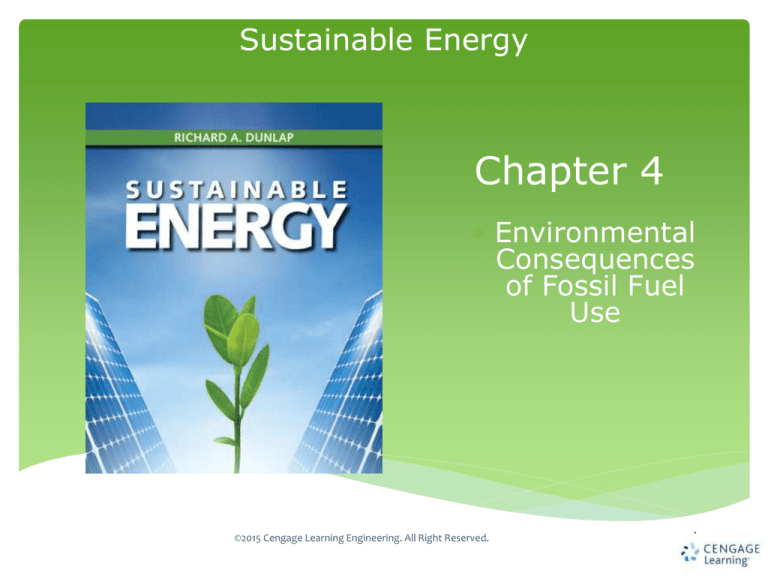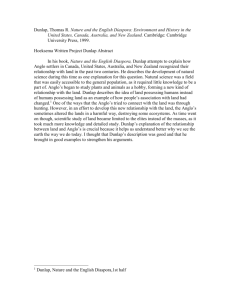
Sustainable Energy
Chapter 4
Environmental
Consequences
of Fossil Fuel
Use
©2015 Cengage Learning Engineering. All Right Reserved.
1
Sustainable Energy
Dunlap
Learning Objectives
●
●
●
●
●
The causes and effects of thermal pollution.
The causes and types of chemical pollution.
Principles of the greenhouse effect.
The reasons for global climate change.
Methods of carbon sequestration.
©2015 Cengage Learning Engineering. All Right Reserved.
2
Sustainable Energy
Dunlap
Pollution
Utilization of fossil fuels as a source of energy
almost always involves combustion.
Combustion of fossil fuels produces several types
of pollution
•
•
•
•
Thermal pollution
Chemical pollution
Particulates
Greenhouse gasses
©2015 Cengage Learning Engineering. All Right Reserved.
3
Sustainable Energy
Dunlap
Thermal pollution
Conversion of thermal energy to mechanical
energy is limited by the Carnot efficiency.
Typical Carnot efficiency for an automobile engine
is ~17% and for a thermal generating station it is
~40%.
The remaining energy is given off to the
environment as excess heat.
©2015 Cengage Learning Engineering. All Right Reserved.
4
Sustainable Energy
Dunlap
Cooling of thermal generating stations
Thermal generating stations that burn coal, oil or
natural gas (as well as nuclear generating
stations) need to release excess heat into the
environment.
Either a body of water or the atmosphere can be
used as a heat sink.
©2015 Cengage Learning Engineering. All Right Reserved.
5
Sustainable Energy
Dunlap
Once-through cooling
A heat exchanger can be used to transfer excess
heat to a nearby body of water (i.e. lake, river,
ocean).
©2015 Cengage Learning Engineering. All Right Reserved.
6
Sustainable Energy
Dunlap
Advantages of once-through cooling
• water has a high heat capacity and carries
considerable heat
• water has a high thermal conductivity and heat
transfer is efficient
• appropriate bodies of water are common (lakes,
rivers, ocean)
• water temperature is relatively stable over the
year
• cooling infrastructure is simple and economical
©2015 Cengage Learning Engineering. All Right Reserved.
7
Sustainable Energy
Dunlap
Disadvantages of once-through cooling
Changes in the ecology of a body of water can
result from
• changes in oxygen content
• changes in temperature
• changes in thermal profile (temperature
gradients)
©2015 Cengage Learning Engineering. All Right Reserved.
8
Sustainable Energy
Dunlap
Air cooling
Transfer of heat to the atmosphere through cooling
towers is in common use at present.
This can cause local regions of increased fog and
precipitation.
©2015 Cengage Learning Engineering. All Right Reserved.
9
Sustainable Energy
Dunlap
Cooling towers
©2015 Cengage Learning Engineering. All Right Reserved.
10
Sustainable Energy
Dunlap
Chemical pollution
Types of chemical pollution associated with
fossil fuel use
•
•
•
•
Carbon monoxide
Nitrogen-oxygen compounds
Hydrocarbons
Sulfur dioxide
©2015 Cengage Learning Engineering. All Right Reserved.
11
Sustainable Energy
Dunlap
Carbon monoxide
CO is produced by the incomplete combustion of
carbon by the reaction
The primarily source of CO is internal combustion
engines in vehicles.
Adverse health effects range from headaches to
death, depending on concentration and exposure
time.
©2015 Cengage Learning Engineering. All Right Reserved.
12
Sustainable Energy
Dunlap
Atmospheric concentration of CO
CO produced by vehicles and dissipates
on a time scale of hours
©2015 Cengage Learning Engineering. All Right Reserved.
13
Sustainable Energy
Dunlap
Effects of emission controls
CO and other pollutants substantially decreased due to
emission standards since 1960s
©2015 Cengage Learning Engineering. All Right Reserved.
14
Sustainable Energy
Dunlap
Nitrogen-oxygen compounds
Nitric oxide (NO) is formed by any combustion
process in air by the reaction
©2015 Cengage Learning Engineering. All Right Reserved.
15
Sustainable Energy
Dunlap
Nitrogen dioxide
NO reacts with ozone (O3) in the atmosphere to yield
Nitrogen dioxide (NO2)
NO2 is highly toxic.
Health effects range from respiratory irritation to heart
damage, depending on concentration and exposure.
©2015 Cengage Learning Engineering. All Right Reserved.
16
Sustainable Energy
Dunlap
Atmospheric concentration of NO2
Daily fluctuations of atmospheric NO2 concentration due to
human activities
©2015 Cengage Learning Engineering. All Right Reserved.
17
Sustainable Energy
Dunlap
Hydrocarbons
Hydrocarbons are produced during the incomplete
combustion of fossil fuels.
Health effects range from eye irritation to lung
disease.
Greatly reduced by emission control standards for
vehicles.
©2015 Cengage Learning Engineering. All Right Reserved.
18
Sustainable Energy
Dunlap
Sulfur dioxide
Sulfur dioxide produced primarily from the oxidation of
sulfur in sulfur-containing fossil fuels (mostly coal)
©2015 Cengage Learning Engineering. All Right Reserved.
19
Sustainable Energy
Dunlap
Acid rain
Sulfur dioxide reacts with oxygen in the atmosphere
This is followed by the reaction with water to produce sulfuric
acid
This acid rain has adverse effects on buildings, vehicles, etc.
©2015 Cengage Learning Engineering. All Right Reserved.
20
Sustainable Energy
Dunlap
Particulate pollution
Particulates are dust particles produced during
the combustion of fossil fuels (primarily coal) or
wood.
Primarily a problem for coal fired generating
stations.
©2015 Cengage Learning Engineering. All Right Reserved.
21
Sustainable Energy
Dunlap
Removal of particulate pollution
Particulates may be removed from smoke of coal fired
generating stations by filtering or electrostatic precipitation
©2015 Cengage Learning Engineering. All Right Reserved.
22
Sustainable Energy
Dunlap
Dissipation of pollution in the atmosphere
Temperature profile for the atmosphere
©2015 Cengage Learning Engineering. All Right Reserved.
23
Sustainable Energy
Dunlap
Adiabatic Lapse Rate (ALR)
The adiabatic lapse rate (ALR) is the normal
rate at which the temperature near the surface
of the earth decreases as a function of
increasing altitude.
This is typically about 10 °C/km.
©2015 Cengage Learning Engineering. All Right Reserved.
24
Sustainable Energy
Dunlap
Stable and unstable atmospheric conditions
Unstable condition: If the actual temperature
decreases faster than ALR warm (polluted) air near
the surface readily mixes with air above it and the
pollution is dispersed.
Stable condition: If the actual temperature decreases
slower than ALR warm (polluted) air near the surface
does not mix with air above it and the pollution is
trapped near the surface.
Temperature inversion: Temperature increases with
altitude near the surface and this severely inhibits
mixing.
©2015 Cengage Learning Engineering. All Right Reserved.
25
Sustainable Energy
Dunlap
Examples of temperature profiles
©2015 Cengage Learning Engineering. All Right Reserved.
26
Sustainable Energy
Dunlap
Health effects of stable atmospheric
conditions
Increased exposure
to high levels of
pollution
London 1952 Estimated 12,000
deaths from excess
exposure to
pollution
©2015 Cengage Learning Engineering. All Right Reserved.
27
Sustainable Energy
Dunlap
Equilibrium temperature of a planet
A planet without an atmosphere and an albedo, a, has incident
solar radiation S (in W/m2)
The total power absorbed by the planet is
The total power radiated is given by the Stefan-Boltzmann law
The equilibrium surface temperate is
©2015 Cengage Learning Engineering. All Right Reserved.
28
Sustainable Energy
Dunlap
The greenhouse effect
If an atmosphere is present then certain molecules in the
atmosphere will transmit the short wavelength solar
radiation but will block the re-irradiated long wavelength
radiation from the planet, leading to an increase in
equilibrium surface temperature.
If the earth had no atmosphere the equilibrium surface
temperature would be about -19°C.
With the present atmosphere the equilibrium surface
temperature is about +11°C.
©2015 Cengage Learning Engineering. All Right Reserved.
29
Sustainable Energy
Greenhouse gases in the
atmosphere
©2015 Cengage Learning Engineering. All Right Reserved.
30
Dunlap
Sustainable Energy
Dunlap
Climate change
CO2 is produced by the combustion of fossil
fuels.
This CO2 adds to the greenhouse gases in the
atmosphere and raises the equilibrium surface
temperature of the earth.
©2015 Cengage Learning Engineering. All Right Reserved.
31
Sustainable Energy
Dunlap
Historical temperature and CO2
concentration trends
©2015 Cengage Learning Engineering. All Right Reserved.
32
Sustainable Energy
Dunlap
Recent CO2 concentration in the
atmosphere
©2015 Cengage Learning Engineering. All Right Reserved.
33
Sustainable Energy
Dunlap
Atmospheric CO2 observed in Hawaii
Oscillations are due to seasonal fluctuations resulting from
vegetation growth
©2015 Cengage Learning Engineering. All Right Reserved.
34
Sustainable Energy
Dunlap
Evidence for global warming
Direct temperature measurements
©2015 Cengage Learning Engineering. All Right Reserved.
35
Sustainable Energy
Dunlap
Other evidence
•
•
•
•
•
•
•
reduction in size of glaciers
reduction in arctic sea ice
increase in sea level
biological changes
increase range of some species
thawing permafrost in arctic
weather fluctuations
©2015 Cengage Learning Engineering. All Right Reserved.
36
Sustainable Energy
Dunlap
Glacial reduction
©2015 Cengage Learning Engineering. All Right Reserved.
37
Sustainable Energy
Dunlap
Predicted temperature changes for
the next century
©2015 Cengage Learning Engineering. All Right Reserved.
38
Sustainable Energy
Dunlap
Possibility of carbon sequestration
Underground - in depleted oil and natural gas
wells
In oceans - trapped in cold regions deep in the
oceans
Solid storage - stored in solids using reactions
such as
©2015 Cengage Learning Engineering. All Right Reserved.
39
Sustainable Energy
Carbon emissions worldwide
©2015 Cengage Learning Engineering. All Right Reserved.
40
Dunlap
Sustainable Energy
Dunlap
Factors affecting carbon emissions
• climate
• sources of energy
• national energy policies
France better than Spain or Italy - extensive nuclear
program may be a factor.
Brazil better than Mexico - extensive biofuels program
may be a factor.
Canada better than Australia - extensive hydroelectric
resources may be a factor.
©2015 Cengage Learning Engineering. All Right Reserved.
41
Sustainable Energy
Dunlap
Summary
• Combustion of fossil fuels produces pollution which can be
•
categorized as
o Thermal pollution
o Chemical pollution
o Particulates
o Greenhouse gases
• Internal combustion vehicles and coal fired generating
stations are the major contributors to the first three
categories
• All fossil fuel combustion produces CO2
• Greenhouse gases contribute to global warming
• Carbon sequestration may mitigate the effects of
greenhouse gas emissions
©2015 Cengage Learning Engineering. All Right Reserved.
42



